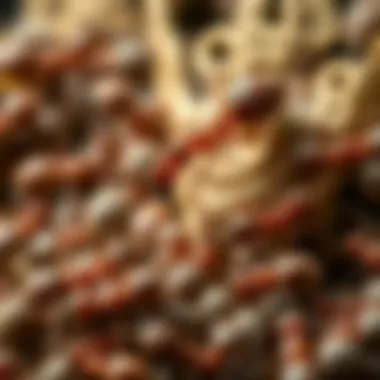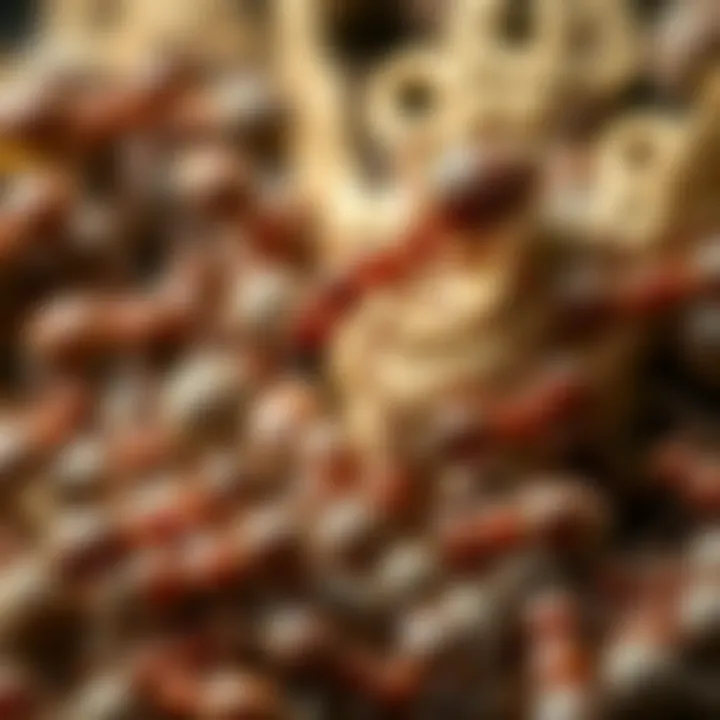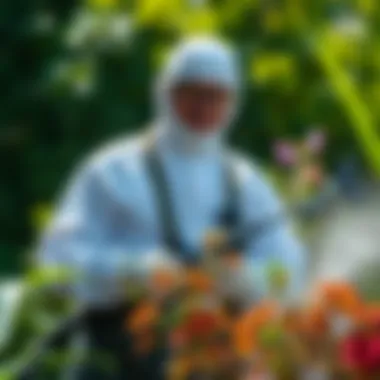Effective Pest Control Solutions in Myrtle Beach


Intro
Myrtle Beach is a gem along the coast, attracting visitors with its sun-soaked shores and vibrant community. However, living in a coastal paradise also means grappling with a variety of pests that can disrupt your tranquil life. Whether you're a newcomer or a long-time resident, understanding how to identify and manage these uninvited guests is crucial. From ants marching across the kitchen to mosquitoes buzzing around your backyard, this guide will lay the groundwork for effective pest control, providing you with strategies that are both practical and environmentally friendly. We will delve into the pests most commonly found in this region, explore dependable prevention techniques, and shine a light on DIY solutions that empower you to take control of your home and surroundings.
Pest Identification
To tackle pest control effectively, the first step is understanding who you’re up against. Identifying pests early can save you time, money, and frustration.
Common Household Pests
In Myrtle Beach, several pests tend to get cozy in homes:
- Ants: Various species, including fire ants and sugar ants, can invade kitchens in search of food.
- Roaches: German and American cockroaches find warmth and moisture in homes, making them prevalent in coastal areas.
- Termites: As the wooden structures age, the risk of termites increases; these wood-munching critters can cause significant damage.
- Rodents: Mice and rats may seek shelter indoors, especially during cooler months.
- Mosquitoes: Along with their annoyance, these pests can transmit disease.
Signs of Infestation
Knowing the signs of an infestation can help you act swiftly before a minor issue turns into a major headache.
- Droppings: Spotting droppings is often the first indicator. Rodent droppings or insect sheddings can be found in shelters or nesting spots.
- Nesting Materials: Shredded paper, fabric, or plant materials often signal rodent presence.
- Chewed Wood or Wiring: Damage to wooden elements or insulation could mean termites or rodents are at work.
- Visible Pests: Of course, seeing insects or rodents scurrying around is a solid indication of a problem.
"An ounce of prevention is worth a pound of cure." – Benjamin Franklin
This age-old saying couldn’t be more accurate when it comes to pest control. With proper knowledge, you can prevent pests from taking residence in your space in the first place.
Prevention Methods
Taking proactive measures can drastically reduce the likelihood of pests invading your home. Let’s explore some methods that can help keep your castle safe.
Environmental Modifications
Altering the environment around and inside your home can be a game changer when it comes to pest control:
- Remove Standing Water: Ensure there are no stagnant water puddles in your yard—you'll keep mosquitoes at bay.
- Trim Vegetation: Keep bushes and trees trimmed away from the house, which can help deter pests from seeking easy access.
- Seal Cracks and Gaps: Inspect beads and corners around windows and doors; seal any openings that could serve as entry points for pests.
Home Maintenance Tips
Simple household chores, when done regularly, can deter pests from making your home theirs:
- Regular Cleaning: Frequent vacuuming and dusting can reduce food sources for pests.
- Food Storage: Store food in airtight containers; forget about those open bags of chips on the counter.
- Garbage Management: Take out the trash regularly and ensure bins are sealed; residual food can attract unwanted visitors.
DIY Pest Control Solutions
If you prefer a hands-on approach, there are severalDIY solutions that can effectively help manage pests in your home without harsh chemicals.
Natural Remedies
Some pests can be deterred or repelled using common household items:
- Diatomaceous Earth: This natural powder helps eliminate crawling pests by dehydrating them quickly.
- Essential Oils: Oils such as peppermint and tea tree can repel roaches and ants when mixed with water and sprayed in entry points.
- Vinegar: A mixture of vinegar and water can keep pests like ants at bay when sprayed along pathways.
DIY Traps and Barriers
Creating your traps doesn’t have to be complicated:
- Simple Ant Traps: Combine sugar and baking soda to lure and trap ants without chemicals.
- Home-Made Fruit Fly Traps: A bowl with vinegar and a few drops of dish soap can catch pesky fruit flies easily.
- Physical Barriers: Use fabric or mesh to cover ventilation points or open windows; this keeps insects at bay while allowing airflow.
For more in-depth methods and local resources, you can always check sites like Wikipedia and US EPA for reliable information.
Understanding Pest Control
Pest control is not just about battling the not-so-friendly inhabitants that can invade our homes. It encompasses a broader understanding of ecological balance and the effect of various pests on health, property, and our peace of mind. In Myrtle Beach, where coastal conditions make humidity and warmth ideal for pests to thrive, grasping the concept of pest control becomes essential for homeowners. The blend of sea air and warmth creates a perfect storm for infestations, making knowledge on the subject not just beneficial, but vital.
The Importance of Pest Control
Effective pest control serves as the first line of defense against various diseases and structural problems. We often think of pests as little household nuisances, but underestimating them can lead to serious consequences. For instance, termites can obliterate the structural integrity of a home in no time. Likewise, many insects such as mosquitoes carry diseases that affect our loved ones. By addressing pest concerns proactively, homeowners in Myrtle Beach can safeguard their health, property, and peace of mind.
It’s not just about removing pests, but also about preventing their return. Each season brings its own set of pest challenges, and being fully aware of these can make a world of difference. In this light, pest control becomes a continuous, vigilant practice rather than a one-time fix.
Pest Control Principles
Understanding the principles of pest control is like learning the rules of a game. Knowing what to expect, and how to react is invaluable. There are several core practices that one should keep in mind:
- Prevention First: The best pest control strategy is keeping the critters out in the first place. This involves sealing entry points such as cracks around doors and windows, and ensuring that garbage is stored correctly.
- Identification: Before jumping into action, identifying the specific pest is crucial. Not all infestations require the same treatment; what works for ants might not work for termites.
- Monitoring: Keeping an eye on any changes in your environment can help catch infestations early. If something seems odd, such as unexplained noises or unexpected droppings, it's time to investigate.
- Integrated Pest Management (IPM): This holistic approach combines various management strategies and practices to prevent pests while minimizing risks to people and the environment. Think of it as a comprehensive plan instead of a series of ad-hoc measures.
A proper understanding of these principles allows homeowners to navigate pest management with a sense of preparedness and calm. It establishes a foundation upon which effective pest control measures can be implemented, ensuring that you’re ready whenever those pesky intruders rear their heads.


Pests Commonly Found in Myrtle Beach
The coastal charm of Myrtle Beach attracts many visitors, but it also creates a haven for various pests. Understanding which pests are commonly found in this area is crucial for homeowners. It allows them to plan effective pest control strategies and maintain their homes. If you're familiar with the local pest landscape, you'll be better equipped to defend your space from unwanted guests. The right knowledge can save you time and money, ensuring a happier living environment.
Insects and Rodents
Termites
Termites are sometimes called "silent destroyers". They can cause severe damage to homes before their presence is even suspected. One particular aspect that should raise alarm is their diet: they feast on wood, which can lead to structural damage over time. In Myrtle Beach, the moisture levels can make conditions ripe for termite infestations. The key characteristic of termites is their ability to create tunnels deep within walls. This makes detection difficult for many homeowners. Their presence underscores the need for regular inspections. On the downside, some treatments can be costly, yet, preventing termite damage is often far more economical than repairing it.
Ants
Ants are another common pest in Myrtle Beach, ranging from the tiny sugar ant to the formidable fire ant. One standout aspect of ants is their social structure; they thrive in colonies, which means that when you see a few, there could be much more lurking nearby. Their ability to exploit even the tiniest cracks or openings makes them a persistent issue. Many people regard ants as less threatening compared to other pests. However, some species can deliver painful bites, or even cause property damage, thereby making them a significant concern. Ants are often easier to manage with prevention strategies like proper waste disposal and sealing entry points.
Bed Bugs
Bed bugs have been making headlines recently, and for good reason. These hitchhikers can come into a home on luggage, clothing, or furniture, and once they establish a foothold, they can be exceedingly difficult to eradicate. A notable characteristic of bed bugs is their nocturnal feeding habits, leaving behind itchy welts on unsuspecting victims. Their presence can lead to stress and sleepless nights, which is distinctly disadvantageous for homeowners. Prompt identification and treatment are essential, making bed bug awareness critical in Myrtle Beach.
Mice and Rats
Mice and rats are often the uninvited guests in many homes. One key aspect to consider is their rapid breeding cycle; it doesn’t take long for a small problem to turn into a full-blown infestation. These rodents are not only a nuisance but they can also spread diseases and damage property with their gnawing. The key characteristic of mice and rats is their adaptability; they can thrive in various environments, including attics and basements. The unique challenge they present is their ability to squeeze through small spaces, exacerbating their prevalence. Controlling these pests often requires a multifaceted approach, including traps and blocking entry points.
Seasonal Pest Activity
Spring and Summer Infestations
Seasonal changes significantly influence pest activity, particularly in the spring and summer. Warmer temperatures trigger the emergence of various pests, making it a vital time for homeowners to be on alert. Ants, termites, and other insects become more active during these seasons, drawn out by the heat and available food sources. This time of year is crucial because successful intervention can help mitigate larger infestations later. The unique challenge here is that most people may not recognize early signs of infestation until the problem escalates, making vigilance key.
Fall and Winter Concerns
As temperatures drop in autumn, some pests reduce their activity while others, like mice and rodents, seek shelter indoors. Understanding these behaviors helps in planning preventive measures. This time is often viewed as a lull, but it’s actually the perfect opportunity to prepare for winter pests. Homeowners should focus on sealing entry points and checking for cracks in foundations. The unique aspect of fall and winter infestations is that they often go unnoticed until the population has already established itself. Recognizing this pattern can be the difference between an easy fix and a drawn-out battle against pests.
Signs of Pest Infestation
Recognizing the signs of pest infestation is crucial for any homeowner. Delaying action can result in significant damage and health risks. Knowing what to look for helps you tackle potential problems before they spiral out of control. Being proactive can ultimately save time, money, and peace of mind. In this section, we’ll dive into the early indicators that should have you reaching for your pest control toolkit.
Recognizing Early Signs
Physical Evidence
One of the most telling signs of a pest problem is physical evidence. This can include droppings, shed skins, or nests, which serve as unmistakable clues to the presence of pests. Recognizing this aspect early is key, as these indicators often signal that a colony or group is already established. The distinct shapes and sizes of droppings tell you which pest is which; for instance, rodent droppings are usually dark, pellet-shaped, and can be mistaken for small chocolate chips, while cockroach droppings are round and can often appear like grains of black pepper. Moreover, these physical signs provide certainty about the type of pest you are dealing with, allowing for a targeted response, making it a popular choice in pest management strategies.
However, keep in mind that not all physical evidence is easily visible. Some pests, like termites, may do their damage within wood or hidden spaces, making inspections critical. Regular check-ups can help catch these signs before extensive damage occurs.
Noises and Smells
Noises and smells are other more subtle indicators that pests may have taken residence in your home. For example, scratching, scurrying, or gnawing sounds, especially at night, can hint at the presence of rodents. Similarly, buzzing or flapping may signify smaller pests like bees or wasps in your attic. These sounds create an eerie ambience in the quiet of your home, but they are communication signals from the pests, alerting you that something is amiss.
On the other hand, smells can be even more influential. A pungent, musty odor might indicate a rodent infestation, while a more sweet, decayed scent often comes from decaying organic materials, usually involving insects. These odors not only alert you to a problem, but they can also serve as early warning signals for health-related risks. Ignoring these cues could lead to serious issues, so always trust your instincts when you sense something strange in the air.
Damage to Property
Damage to your property is perhaps one of the most visible signs of pest infestation. Holes in walls or woodwork, gnawed furniture, or insulation showing evidence of nesting all indicate that pests love your home as much as you do. Different pests have specific types of destruction they cause. For example, termites usually eat wood from the inside out, often escaping notice until severe damage has occurred, while ants might tunnel through insulation or electrical wires, posing potential fire hazards.
Moreover, beyond just material damage, the presence of these pests can lead to a decline in your home’s value. Damage that is not promptly repaired can also lead to hefty repair bills over time, making it a costly problem to overlook. Keeping an eagle eye on the condition of your home is always a wise move.
Recognizing these signs early is tantamount to preventing further issues. Keep watch, look for clues, and address any concerns immediately.
Preventive Measures
Preventive measures are the first line of defense when it comes to keeping pests at bay in Myrtle Beach. Implementing effective strategies not only saves you time and money in the long run but also protects your home from potential damage. A proactive approach helps reduce the likelihood of infestations before they start, fostering a healthier living environment for you and your family.
Managing Indoor Spaces
Sealing Entry Points
One of the most crucial steps in pest prevention is sealing entry points around your home. These gaps can be found in various places, including windows, doors, and even small cracks in the foundation. Insects like ants and termites can exploit these vulnerabilities, making sealing such points an essential practice.
An effective sealing strategy provides a dual advantage: it prevents pests from entering while concurrently improving your home’s energy efficiency. Using materials like caulk or weather stripping to close off these entryways is both cost-efficient and easy for the average homeowner. This method makes your house less appealing to gusts of outside pests, channeling them away rather than giving them a red carpet to walk on.
However, one must keep in mind that while sealing entry points is highly beneficial, it requires regular inspection and maintenance. Over time, wear and tear can create new vulnerabilities, so routine checks are advisable to keep your defenses intact.
Proper Sanitation Practices
Another pillar of pest prevention is practicing proper sanitation. This means ensuring that your home is clean and clutter-free, reducing the food sources and habitats that pests thrive on. Regularly cleaning surfaces, vacuuming, and disposing of waste properly creates an unfriendly environment for insects and rodents.


The beauty of proper sanitation lies in its simplicity. It’s an easily achievable practice that benefits both your home’s appearance and your family’s health. Additionally, this method acts as a deterrent to pests, as they tend to find untouched crumbs and residues inviting.
Nevertheless, maintaining high sanitation standards requires effort and consistency. Skipping even one cleaning day can provide a foothold for pests. So, setting a routine for cleaning can help keep those pesky intruders from feeling at home.
Outdoor Recommendations
Landscaping Considerations
Landscaping around your home can play a vital role in pest control. Utilizing plants that deter pests, like marigolds or lavender, can naturally keep unwanted visitors at bay. Moreover, proper maintenance of your yard contributes significantly to preventing infestations.
Key characteristic: Well-trimmed shrubs and grass limits hiding places for pests, while also enhancing your home’s curb appeal. If you're diligent with your landscaping, it can become a natural barrier against pests.
That said, improper landscaping can create havens for pests, especially if there are overgrown plants or debris. It's a balancing act—presenting a beautiful landscape while ensuring it’s not a welcome mat for insects.
Standing Water Management
Standing water is a breeding ground for pests, especially mosquitoes, which thrive in stagnant environments. Managing this water source is key to your pest control strategy. Regularly checking and draining any areas where water accumulates can drastically reduce the mosquito population around your property.
Key characteristic: This practice not only minimizes mosquito breeding but also provides a safer outdoor experience for your family. Consequently, maintaining a clean and dry yard prevents pests from becoming a serious annoyance.
However, it’s important to recognize that eliminating standing water may require ongoing effort, especially after heavy rains. As such, formulating a plan for the management of outdoor water sources, including gutters and bird baths, is essential.
Effective pest management hinges on understanding your environment and making conscious efforts daily. With preventive measures in place, homeowners can significantly reduce the likelihood of pest infestations.
Pest Control Solutions
Effective pest control solutions are vital for protecting homes, families, and businesses from the relentless onslaught of various pests. In Myrtle Beach, where the coastal climate can breed a host of unwelcome critters, both professional services and DIY techniques play essential roles. By addressing the specific needs and challenges posed by local pests, homeowners can create a comprehensive strategy that provides long-term relief from infestations.
Professional Pest Management Services
Evaluating Pest Control Companies
When faced with pest problems, the choice of pest control companies can significantly influence the outcome of any pest management strategy. It’s crucial to evaluate potential companies on several factors, including reputation, services offered, and customer feedback. A well-established company often outshines others simply due to their experience and reliability in handling local challenges. Checking for licenses and certifications can also spare homeowners from potential headaches later. Moreover, professionals bring specialized knowledge about Myrtle Beach’s pest patterns and behaviors, which can significantly enhance treatment efficacy.
Key to consider is the availability of customized plans tailored to the specific pest issues one may face. Many of these companies offer comprehensive inspections to assess the extent of the infestation. This individualized approach makes evaluating pest control companies not just a choice, but a smart strategy when looking for effective and durable solutions.
"Choosing the right pest control company can make all the difference; it’s worth doing your homework."
Understanding Treatment Plans
Once a pest control company is selected, understanding their treatment plans is crucial. Each plan typically includes a mix of initial treatment and follow-ups, designed to eliminate pests and prevent recurrence. The key characteristic here is that treatment plans are usually tailored to the specific pest and situation—be it termites devouring wood or ants marching through the kitchen.
A thorough understanding of these plans will help homeowners know what to expect, including the procedures involved and the estimated timeframe for results. Having clear expectations can alleviate anxiety and foster cooperation between the technician and the homeowner. Moreover, many companies provide explanations about the chemical and operational processes involved, ensuring that clients feel informed and secure about the methods being employed. These insights can lead to long-lasting relationships built on trust, as effective treatment is often accompanied by ongoing support and advice.
DIY Pest Control Techniques
For those inclined towards self-management, DIY pest control techniques provide an alternative to hiring professionals, often at a reduced cost. While these methods might not be as robust as professional treatments, they can effectively mitigate minor infestations when applied correctly.
Nontoxic Solutions
Using nontoxic solutions is an attractive choice for many homeowners who wish to avoid exposing their families and pets to harmful chemicals. These methods primarily leverage natural ingredients and simple household items, such as vinegar or baking soda, to deter or eliminate pests. Their key characteristic is safety while still providing practical pest control methods.
Homeowners often appreciate how easy it is to make and apply these solutions without extensive equipment. These eco-friendly strategies can be a practical and proactive way to address pest issues, especially for those looking to prevent infestations before they escalate into larger problems. Nevertheless, it’s essential to note that while nontoxic solutions are generally safer, they may require a more involved approach or consistent application to achieve desired results.
Homemade Traps and Repellents
Homemade traps and repellents can provide an efficient, creative means of pest control that stands out for its simplicity. Utilizing everyday tools and materials, homeowners can craft effective traps designed for specific pests, such as sticky traps for fruit flies or baited jars for crawling insects. This hands-on technique benefits from personal customization and can be adjusted based on effectiveness.
The unique feature of these homemade solutions lies in the ability to experiment based on individual situations. Not only does this give homeowners a sense of ownership over the pest control process, but it can also be a fun activity when involving family members. However, while these solutions may work well for minor issues, one must acknowledge that their effectiveness often diminishes with larger infestations, making it important for residents to monitor situations closely.
Sustainable Pest Control Practices
Sustainable pest control practices are crucial for maintaining a balanced environment while effectively tackling pest issues in Myrtle Beach. The coastal setting, with its rich biodiversity, demands an approach that respects nature while safeguarding homes from invasive species. Homeowners are increasingly aware that conventional pest control methods often rely heavily on chemical pesticides, which can harm not just the targeted pests but also beneficial insects and the surrounding ecosystem. This is where sustainable practices come into play, focusing on long-lasting solutions that align with environmental health.
In this regard, adopting eco-friendly methods offers several benefits. These practices often use natural substances or less-harmful chemicals, minimizing exposure to hazardous materials. Effective sustainable pest control does not just deal with the symptoms of infestations; it also addresses the underlying issues, such as environmental conditions that attract pests. A fundamental element of sustainable pest control is reducing reliance on chemicals while enhancing effective pest management strategies and solutions.
Eco-Friendly Pesticides
Eco-friendly pesticides are an essential component of sustainable pest control. Unlike traditional pesticides, which can linger in the environment and pose risks to human health and wildlife, eco-friendly options typically break down quicker and have less harmful effects. These products can be derived from natural ingredients, including plant extracts and minerals. One popular choice is diatomaceous earth, a naturally occurring substance that effectively deters various pests without adverse environmental impacts.
When choosing eco-friendly solutions, it’s important to consider their effectiveness and safety. Some commonly used eco-friendly pesticides include neem oil and pyrethrin, both known for their insecticidal properties without the toxic side effects often associated with synthetic chemicals. One challenge, however, is that these solutions may sometimes take longer to work when compared to harsh chemicals, requiring a bit more patience from homeowners. Nevertheless, over time, these options can prove to be just as effective in controlling pests without jeopardizing the surrounding ecosystem.
Integrated Pest Management (IPM)
Integrated Pest Management, or IPM, is a holistic approach that emphasizes the combination of different management strategies to control pest populations sustainably. This method recognizes that pests are a natural part of the environment and, when managed correctly, they can coexist with human activities.


Combining Methods for Efficiency
The heart of IPM lies in the combination of various methods for enhanced effectiveness. This could involve using biological control agents, like ladybugs to target aphids, alongside habitat modification, such as removing standing water to deter mosquitoes. IPM focuses on prevention, monitoring, and intervention… the time-honored adage of „a stitch in time saves nine“ rings true here. By addressing the various aspects that contribute to pest infestations, homeowners can significantly reduce the likelihood of pest outbreaks. One key characteristic of this method is that it often encourages community involvement. Residents who share knowledge about local pest patterns and control methods not only build a stronger community but also foster a more thorough understanding of pest control for everyone involved.
While combining strategies boosts effectiveness, it’s crucial to remember that not all methods will be suitable for every situation, making ongoing education and adaptability pivotal elements of IPM.
Long-Term Solutions
IPM is also known for offering long-term solutions to pest problems. Unlike short-term remedies that merely mask problems, IPM addresses the root causes of infestations. This might include strategies like improving sanitation practices, altering landscaping, or even educating the community on the importance of maintaining their properties. One vital characteristic of these long-term solutions is that they often require a higher initial investment of time and effort. Homeowners may need to commit to ongoing monitoring and adjustments to their practices to align with changing pest behaviors and environmental conditions.
However, the trade-off is a significant reduction in the need for chemical interventions, leading to safer and healthier living environments. Ultimately, these long-term methods save homeowners both money and time in the grand scheme, as the approach is centered on preventing issues rather than reacting to them after they arise.
"A proactive approach is always better than a reactive one; prevention is key when dealing with pests."
In constructing a pest management plan, awareness of both eco-friendly pesticides and IPM techniques is invaluable. Homeowners in Myrtle Beach can use these practices to create a pest control strategy that not only protects their homes but also promotes a sustainable environment for the whole community.
The Role of Local Regulations
Understanding local regulations surrounding pest control is vital for homeowners in Myrtle Beach. These laws not only protect the community but also ensure that pest management practices are both effective and environmentally sound. Knowing the rules can save headaches down the road, and it’s always smart to stay on the right side of the law when dealing with pests.
Pest control often involves using pesticides and other substances that can impact the local ecosystem. Hence, state and local regulations provide guidelines on what methods and materials can be used safely, minimizing risks to both human health and wildlife. Many homeowners might find this a tedious subject; however, grasping the local laws helps in making informed decisions regarding pest control methods.
Additionally, understanding these regulations can foster stronger community ties. Local governments frequently collaborate with residents to develop pest management strategies tailored to their specific environments and challenges. When the regulations are adhered to, everyone benefits—pests are managed effectively without compromising safety or environmental health.
Local regulations ensure pest treatments are safe for your family and the environment. Ignoring these can lead to unwanted consequences.
State and Local Laws
In Myrtle Beach, state and local laws set the groundwork for how pest control should be conducted. South Carolina has declared specific guidelines that dictate which types of pesticides can be used and how they should be applied. Homeowners should become familiar with terms like "registered pesticides" and "restricted use" pesticides, which refer to substances regulated to safeguard public health and the environment.
For homeowners engaged in pest control, the following points must be considered:
- Consult the South Carolina Department of Pesticide Regulation: This department oversees pesticide registration and usage, ensuring that homeowners are utilizing approved products.
- Local ordinances: Many cities, including Myrtle Beach, may have ordinances that govern specific pest control practices, which may include bans on particular chemicals or certain application methods.
- Reporting procedures: Any adverse effects from pest control practices should be reported to local regulatory agencies to help keep the community informed and safe.
Obtaining Necessary Licenses
Licensing is another important aspect to consider when dealing with pest control in Myrtle Beach. Those wishing to engage in pest management activities—especially on a professional level—must adhere to strict licensing requirements. There are numerous pathways to secure these licenses, depending on the scope of pest control work intended.
Homeowners wishing to try their hand at DIY pest control must also be aware that some substances may require licensure for legal application. While many over-the-counter pest control products do not need a license for home use, its always best to double-check before using commercial-grade tools or applications.
Overall, licensing ensures accountability and competence within the pest control sphere. Homeowners are advised to:
- Check local laws: Determine if a license is needed based on the type of pest control methods they wish to use.
- Stay informed about changes: Pest control regulations can evolve, so keeping tabs on updates from local authorities is vital.
- Consider professional services: If the task seems daunting, hiring licensed pest control professionals could save time and effort, while also ensuring compliance with local regulations.
By staying well-informed about regulations and licensing, homeowners in Myrtle Beach can approach pest control more confidently and responsibly.
Community Resources for Pest Control
In dealing with pests that can turn your home into their playground, community resources play a crucial role. They can offer valuable support, guidance, and information on managing pest issues effectively. In a place like Myrtle Beach, where the coastal climate attracts a variety of pests, tapping into these local resources can be a game changer.
Local Cooperative Extension Services
Local Cooperative Extension Services are fantastic for homeowners seeking help with pest control. These services provide research-based information and guidance tailored to your specific region. They focus on promoting effective practices in agriculture and home gardening, which includes pest management. Here are some highlights of what they can offer:
- Educational Programs: You can find workshops and seminars aimed at educating the local community about pest identification and control methods. Learning from experts helps in understanding what you’re truly up against.
- Access to Resources: Many extension offices have fact sheets, pamphlets, and other printed materials that can explain pest behavior and effective control techniques. This information is often tailored to local species, which is essential.
- Soil and Plant Testing: If you're dealing with pests related to your garden or yard, these services often provide testing for soil health and plant diseases, which can indirectly help with pest issues. Healthy plants are less likely to attract pests.
- Advice on Chemicals: Cooperative Extension Services can give insights into the safe use of pesticides and other treatments, ensuring that you make well-informed decisions that balance effectiveness with safety for your family and pets.
Utilizing these services could save homeowners a lot of grief while ensuring that pest control measures are responsible and sustainable. For further information, you can contact the local extension office in Horry County by visiting South Carolina Cooperative Extension
Online Support Networks
In today’s digital age, online support networks for pest control are abundant. These platforms bring together homeowners, professionals, and enthusiasts who share common experiences and solutions. Engaging with these online communities can be incredibly beneficial for anyone trying to tackle pest issues at home.
- Forums and Discussion Groups: Websites like Reddit host specific subreddits such as r/pestcontrol where users can post questions or share their personal experiences with pest infestations. You’re likely to find someone who's faced the same problem and can offer firsthand solutions.
- Social Media Groups: Facebook groups dedicated to home care or local neighborhood issues often include pest control discussions. Here, you can find quick tips, product recommendations, and sometimes even local pest control recommendations.
- Blogs and Informational Websites: Many pest management professionals maintain blogs where they share tips, tricks, and the latest industry news. Resources like National Pest Management Association can provide valuable information on pest control trends and methods.
- DIY Videos: Platforms like YouTube are filled with visual guides from pest control experts explaining various control methods. Visual learning can be particularly effective for those who benefit from seeing techniques in action.
Caution is crucial, of course. Online advice should always be weighed with a critical eye, as anyone can post information without verification. Still, these communities can be a lifeline for those seeking guidance and support when dealing with unwelcome invaders.
Finale
In the realm of pest control, understanding the complexities surrounding various pests and their management is crucial, especially for residents of Myrtle Beach. This article has traversed the landscape of pest control, highlighting not just the common creatures that wreak havoc in our homes, but also the strategies to effectively combat them. Homeowners and housewives alike stand to benefit significantly from embracing a proactive approach to pest management.
Summary of Key Points
From understanding the local pest ecology to recognizing the early signs of infestation, each section of this guide has provided valuable insights:
- Common Pests: Identifying pests like ants, termites, and bed bugs helps in addressing infestations quickly.
- Preventive Measures: Sealing gaps and maintaining cleanliness plays an essential role in keeping pests at bay.
- Professional vs. DIY Solutions: Whether opting for professional services or attempting do-it-yourself methods, knowing the available options empowers homeowners.
- Sustainable Practices: Eco-friendly pest control methods reflect a growing awareness of environmental impacts and long-term effectiveness.
- Local Regulations: Adhering to state and local regulations ensures that pest control efforts are both legal and safe.
"Knowledge is power when it comes to pest management. Equip yourself, and you'll outsmart the critters."
Final Thoughts on Pest Control
It's worth noting that pest control isn't merely about exterminating bugs; it’s about creating a harmonious living environment. The combination of vigilance, education, and suitable actions can pave the way for a pest-free home. With the right knowledge, you can transform a daunting subject into an achievable goal, protecting your space effectively while being mindful of ecological considerations.
In the dynamic coastal habitat of Myrtle Beach, an informed homeowner is a powerful ally against encroachments by pests. Armed with the information from this guide, take charge of your home’s pest management. After all, a safe and healthy home is the ultimate reward for your diligence.















